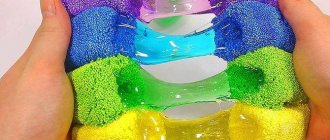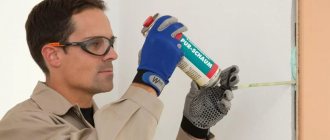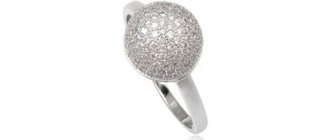Housewives often face the problem of how to wash an acrylic bathtub at home? The walls and bottom are sensitive to abrasive substances, so a product chosen at random will not work. The purpose of the article is to talk about the basic rules and methods of cleaning, give practical advice and recommendations:
- characteristics of cleaning products, their features;
- cleaning options - what they are, the main differences;
- Tips for caring for and extending the service life of your bathtub.
Acrylic is a wear-resistant material, a type of plastic that comes from a group of synthetic derivatives of one of the unsaturated organic acids.
What should you know about the characteristics of acrylic bathtubs before cleaning them?
Before answering the question of how and what to wash an acrylic bathtub, let’s talk about the material used. Acrylic has a dirt-repellent effect: microorganisms, bacteria and fungi do not develop in the bathtub. The material is durable and resistant to impacts. A noticeable disadvantage is that it is easily scratched and subject to wear.
The main difference is exposure to abrasive and chemically active components. Like plastic, substances with high alkalinity or acidity lead to degradation of the structure, and abrasives scratch the surface, leaving deep grooves.
It is important to be careful when washing. Do not buy abrasive compounds, pastes with ammonia, chlorine, acids and alkalis. Powdered products are harmful, leaving damage and scratches. Brushes (metal and with hard bristles) are contraindicated for use.
How to care for an acrylic bathtub
To begin with, it must be said that the conditions for caring for a bathroom in our country are somewhat different from the conditions in other countries. This is due to the quality of the water we use.
In this regard, we will need to more carefully and regularly take care of the acrylic bathtub.
- It is necessary to use only liquid care products for acrylic surfaces. These preparations should not contain abrasive substances that can scratch the delicate structure of this material;
- You can really restore the shine of the surface by using a soft cloth soaked in furniture polish;
- Stubborn stains can be removed using household products designed for smooth surfaces;
- Two or three times a month it is necessary to thoroughly clean the acrylic bathtub with special detergents, of which there are a large number. Instructions for use are written on the packaging.
- To avoid the formation of rust on the surface of the bathtub, you need to tighten the taps tightly.
- It is recommended to bathe animals by protecting the bottom of the bath with a mat. You will avoid unwanted scratches, and the surface will not slip.
- Each time after using the bathtub, it should be cleaned with a mild detergent and rinsed with plenty of water. Next, wipe the bath with a dry towel and leave it like that until next use.
- Don't despair if you find a few superficial scratches. They can be easily cleaned with fine-grained sandpaper. Next, these places are simply polished with liquid detergent.
How to clean an acrylic bathtub at home: TOP 5 ways
We have selected several options for you on how to clean an acrylic bathtub at home:
- detergent;
- lemon acid solution;
- vinegar;
- soda;
- toothpaste.
We recommend using the methods outlined above if the contamination in the bathroom is significant (after renovation, from rust). In other cases, use special liquids available on the market.
Detergents
An adequate and simple way is to use special detergents. Their cost rarely exceeds reasonable limits. For correct selection, make sure there are no abrasives. Often the ingredients are indicated on product packaging, or special notes are made.
Acrylic bathtub cleaner is used for small and large cleaning volumes . Appearing stains are removed using:
- Cif – for bathtubs, sinks, tiles and toilets. The composition does not contain abrasives, which is safe for acrylic. The reasonable price and variety of composition types (spray, paste, cream) make it a popular product among buyers. After cleaning, a film appears that protects it from further formation of limescale.
- Acrilan - foam for baths and showers. When using, leave only until completely dry, without rinsing.
- Bass is a cleaning product that is used daily. Sold in liquid form.
- Tim-Profi is an environmentally friendly product, helps fight unpleasant odors, and is effective for heavy soiling.
- Cinderella is a popular substance that emits a pungent odor, so when spraying (sold as a spray), wear gloves and a special mask.
- Chister is a composition for quickly removing dirt, promoting the decomposition of stains and grease stains. Consists of a polymer that protects against fungi.
Video: How to properly wash an acrylic bathtub?
The following video offers tips on how to properly clean an acrylic bathtub, and also tests ways to clean it using toothpaste and a special solution:
Acrylic bathtubs are becoming increasingly popular because, thanks to their unique structure, this material does not accumulate pollution. The polymer's minimal number of pores makes it easy to remove fresh stains, and the smooth surface creates a barrier for the accumulation of germs and dirt. However, acrylic bathtubs have certain operating conditions and require careful and careful care.
Table: type of contamination - cleaning recommendation
Let's look at the main ways to clean an acrylic bathtub:
| Problem | Solution |
| From yellow spots | Tooth paste. Cleans acrylic and returns its whiteness. |
| Rust | Soda. The structure does not scratch, but will cope with serious stains. |
| Sealant | Lemon juice. Corrodes any mixture, including sealant. |
| Limescale | Vinegar. It should be used rarely, but it does a good job of removing plaque. |
| Glue | Lemon acid. |
Contraindications: what not to use when cleaning
A few words about how not to clean an acrylic bathtub at home. We do not recommend using:
- Acetone - corrodes plastic and causes holes to appear.
- Abrasive substances damage the surface, leaving scratches and reducing the thickness of the enamel.
- A mixture of several components creates the opposite effect, scratching the walls.
The appearance of acetone in the room should be completely eliminated. The element is chemically active and acts as a solvent. 10-20 ml is enough to make a dent on the surface of the structure.
Wash off active chemicals with cold water. High temperature increases the reaction rate and surface damage will occur faster.
General rules for care and use
To care for an acrylic bathtub, purchase special liquids or use home remedies. The main thing is that they are intended directly for washing polymer coatings.
Acrylic surfaces cannot be cleaned with powders, liquids, ammonia, alkali, acid, or chlorine. Choosing a detergent with abrasives and acid will change the performance characteristics of the acrylic or significantly damage the surface. If you use a product with alkali or high acidity, this will damage the integrity of the material structure. The abrasive components in the cleaning solution will leave deep grooves and scratches on the acrylic surface.
For cleaning, use soft sponges or cotton rags. Microfiber cloths can be an alternative. After cleaning, wipe the bath with a soft towel or cloth. It is not advisable to use very hot water for washing, as this will lead to a change in the shape of the material.
You cannot store metal basins or buckets in an acrylic bathtub, or bathe pets - claw marks may appear on the surface of the polymer.
Daily care at home
The plastic surface is easily cleaned from fresh dirt. Timely cleaning of the acrylic bathtub will prevent the appearance of limescale and rust.
Each time after taking a bath, rinse its surface thoroughly with warm water. Manufacturers warn that water temperatures above 70 degrees can cause acrylic to deteriorate. For daily washing, you can use a solution with laundry soap. It should be remembered that experts do not recommend frequently using chemicals, even those designed for processing polymers.
Don't leave the bathroom wet. You can dry it with a soft cloth or prolonged airing. Disinfect the bath several times a week. This period can be increased or decreased depending on the degree of contamination of the tank.
Compatibility of detergents with acrylic surfaces
Is it possible to wash an acrylic bathtub with Domestos or a mixture of substances? It is not advisable to mix with:
- Formaldehyde - they are not compatible with acrylic.
- Chlorine - its use forms pores, shortening the service life of the product.
- Acetone , ammonia - corrode the walls.
Domestos, Sanox, Pemolux and Selite contain hydrochloric acid, which destroys protection. Initially, it is bleached, but then it absorbs plaque, becoming dirty faster. Therefore, such detergents cannot be used.
Disinfection with white
An acrylic bathtub is a way to forget about fungus forever, but it’s not ideal either. The fungus does not appear on the material, but easily multiplies on plaque, fats and other organic substances with nutritious microflora. Contamination should not be allowed to appear for a long time, and if it does appear, complete disinfection should be carried out periodically.
Fill the bathtub with water at room temperature;
- Add 2 liters of white (7%);
- Do not touch for 10–15 minutes;
- Rinse off the water and refill;
- Remove any remaining bleach and drain the water;
- Wipe dry with a cloth.
Methods for removing yellowness from an acrylic bathtub
Yellowness from the surface of an acrylic bath can be removed in the following ways:
- To carefully whiten an acrylic bathtub, it is recommended to mix ammonia and hydrogen peroxide
. This composition must be wiped with a soft cloth. - Use equal amounts of lemon juice and vinegar
. They are mixed and applied to the surface using a sponge. - Apply laundry bleach
. To do this, the powder is diluted with water to make a paste and applied to the stains. Leave until the paste dries, then wash it off with clean water and wipe with a rag. - Treat the surface of the bath with apple cider vinegar
, then rinse with water.
Rules for proper use
The bath does not require serious care, but it is still necessary to follow the rules.
- Periodically bringing the plumbing to a decent condition in 5 minutes - after water procedures, rinse with clean water . Acrylic does not absorb dirt, so this type of washing is sufficient.
- After use, wipe the bathtub with a sponge and soapy water . Next, dry to avoid streaks.
- restoration kits for removing scratches - they are sold in hardware stores.











